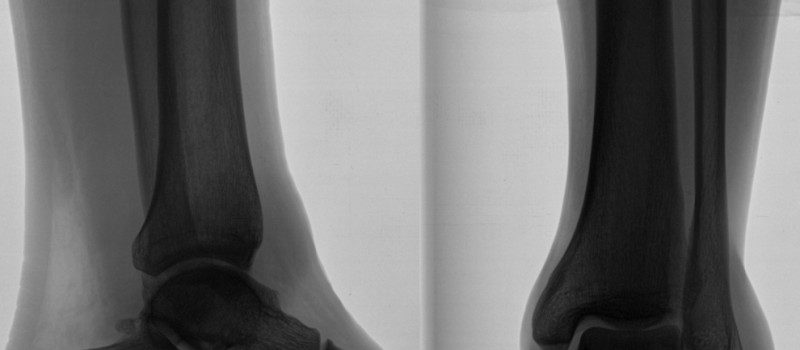
The Dreaded “High Ankle Sprain”
When our Edmonton Oilers young gun Taylor Hall went down with a high ankle sprain, I was asked by many patients why he was out for the season. Were the Oilers medical staff just being protective of Taylor Hall or was it really a serious injury. Let’s take this opportunity to understand what the injury is, how long it takes to recover and what the various stages Taylor Hall’s recovery entailed.
What is a high ankle sprain?
Unlike other ankle sprains, this injury is sustained to the tissue (ligaments) that connect the tibia and the fibula. These are the bones that make up the lower leg (the inner bone being the tibia or shin and the outer being the fibula).
With common ankle sprains “low ankle sprains” the ligaments that are most often injured are the ones on the outside of the ankle. These help to connect the fibula to the foot. These ligaments are injured when someone “rolls” their ankle over. Generally, recovery occurs over a period of 4 to 6 weeks. Most of us have sprained our ankle in this manner and as the swelling goes away, so does the pain. This isn’t to say that these ankle sprains aren’t serious, but in the majority of instances they resolve uneventfully – or at least we feel that they have.
In the high ankle sprain, there are several structures potentially damaged. These include ligaments that connect the tibia to the fibula known as the tibfib ligaments, as well as a tissue called the interosseous membrane. The severity of this injury often depends on how many of these structures are damaged. The recovery time frame varies from 8 weeks to 6 months and this is why the high ankle sprain is so dreaded.
What are the symptoms of a high ankle sprain?
With a high ankle sprain there is often a minimum degree of swelling but unfortunately there tends to be more and longer lasting pain. The pain that occurs with this type of sprain will usually occur when the ankle is turned outward and will be noticed above the ankle. This tendency and the fact that the ligaments are above the ankle lead to the term “high ankle sprain.” Most athletes are diagnosed with these injuries when their ankle sprain takes longer to recover than usual. Clinical diagnosis is based on pain location, palpation, observation and a test known as the “squeeze test.” In Taylor Hall’s case, an MRI would have clearly identified the injured ligament/s, but x-rays by a physician can also play a roll in diagnosis.
How does one get a high ankle sprain?
The common mechanism of injury is sport and most often they occur during forceful twisting outward of the ankle. This injury is more common in football, hockey, wrestling and soccer. In these sports the opportunity to become tangled under another person is increased. The outward twisting motion of the ankle will cause the two bones to pull away from one another and tear the ligaments that connect them.
tear the ligaments that connect them.
Another way to injure these ligaments is via hyperdorsiflexion – which means that the toes are forced toward the shin beyond their normal range. This will occur when an athlete has his foot planted and falls or is pushed forward. In either event the splaying (pulling apart) of the two bones causes the ligaments to tear.
How is a high ankle sprain treated?
- When identified early a stable high ankle sprain is treated with a cast or roho boot for the first 6 weeks. Once the cast is removed, the real tough part of the recovery begins. At this point, due to the immobilization, the joints from the ankle to the toes are very stiff. The physiotherapy is key to restore the lost motion, strength, balance and of course to teach the athlete how to walk and run properly again.
- If missed, the immobilization is usually absent and the ankle sprain is treated very similar to other sprains, but with a lot more patience, plenty of rehabilitation and there is often a need for more caution on return to sport. This caution is necessary because of the possibility of ongoing instability.
- If the sprain is determined to be unstable, the bones of the lower leg require surgical stabilization usually via a screw. I will leave this procedure to the blogs of orthopedic surgeons.
Final thoughts on ankle sprains in general:
In my practice I hear from people that they “always sprain their ankle” or that it’s “just a sprain.” I must make a point that the time to deal with any ankle injury is immediately! There are many degrees of ankle sprain and as you have now read, many different types of ankle sprain. Determining the injury type and severity will go a long way to ensure that your ankle recovers properly. As well, just because the swelling is going away and the pain decreases, this does not imply that the ankle has healed properly. Loss of range of motion, scar tissue and persistent instability are all complications of ankle sprains – even minor ones.
Taylor Hall was in good hands and I am pretty certain that Taylor Hall wouldn’t have said: eh, its just a sprain, I’ll worry about it later. Why would you?
Grant Fedoruk

I twisted my ankle outwards doing a slide tackle, heard a big snap but i could still put weight on it later that day but just not twist on it.
Its been three weeks and I can walk but not jog, the pain is around my ankle and my achilles but also hurts up my shin.
I didnt go hospital because I could put weight on it the next day and therefor never had a boot on it.
Do you think it will be fine after a few weeks or should I still go hospital?
I sprained my ankle a week ago and the ER said it was a bad sprain well they gave me a plastic splint and 3 days after the injury i could walk and there would be a little pain now there is no pain at all what do i do tomorrow is the last day of school and i really want to wear both boots and not use crutches i feel like i am running a marathon every time i use those thing and Florida heat dont make it better
hello! About six weeks ago, I was at my badminton practice. I tripped and fell on my right ankle. At the moment I tought I was ok, but a few seconds after, the pain began. Soo I couldn’t put any weight on my foot. So the same night I went at the hopsital. I took an x Ray and it didn’t show anything. Like I knew he was gonna tell me, he said to put like a sling for a week and if it didn’t improved I needed to go back.( actually it came worse. The swelling wasn’t as bad but a bruise showed up and there was no circulation in my foot). So a week after, there I was again at the hospital. That doctor took another x Ray and told me that nothing was showing again. But she took my case a little more seriously, and she gave me a half cast for a week then to go back and see. Week three: I arrive and this doctor gets my cast thing off. He checks it and tells me that I’ll have the half cast for another 5 weeks(or close). Then I could put weight on it on the last week(I had to get the cast off and walk a little). Here I am today, going at the doctor tomorrow, on my week 6 and it still hurts like my week 2. I don’t know what to do? What will happen?? The bruise is a little better, there is no more swelling, but still no circulation. Doctors didn’t even tell me what I had! Anyone can help me? Could I possibly get an operation or something?
I took this ankle pains some weeks ago and most if the times that I walk u feel no pain unlike before when I could hardly walk without feeling some pain. Now its only when am running that the pain starts to set in. am even having doubt if its even going to heal because it was almost untreated in the first week and I fear that will result in rendering this ankle sprain of mine somewhat permanent. any advice?
Hi i sprained my ankle like 4 and half weeks ago and i just wanted to thank you because i read your blog right after i sprained it and it helped me so much. I get to start playing my sports tomorrow and you definitely help save my high school career. My ankle sprain was so bad to the point were i have a high ankle sprain and a regular ankle sprain and the welling is suppose to last 1 year to a year and half. i had no pain 3 weeks into my sprain but didn’t have full movement.Again i really appreciate your blog and thank you so much!!!!!!!!!!!!!!!!!!!!!!!!!!